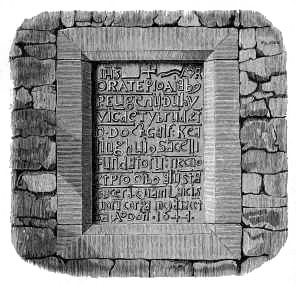Geoffrey Keating
History and theology were the two great studies of the middle ages, and to these subjects we find the literati of Ireland directing special attention. The importance and value of Latin as a medium of literary intercommunication, had been perceived from an early period: hence that language was most frequently employed by Irish writers after it had become known in the country. It is unquestionably a national credit, that no amount of suffering, whether inflicted for religious or political opinions, deprived the Irish of historians.[2] Some of their works were certainly compiled under the most disadvantageous circumstances.
None of the writers whom we shall presently enumerate, worked for hope of gain, or from any other motive save that of the purest patriotism. Keating, whose merits are becoming more and more recognized since modern research has removed Celtic traditions from the region of fable to the tableland of possibility, wrote his History principally in the Galtee Mountains, where he had taken refuge from the vengeance of Carew,[3] Lord President of Munster. Although he had received a high education in the famous College of Salamanca, for the sake of his people he preferred suffering persecution, and, if God willed it, death, to the peaceful life of literary quiet which he might have enjoyed there. He wrote in his mother-tongue, although master of many languages; and in consequence of this choice his work remained in MS. for many years. When it came to light, those who were ignorant of the MS. materials of ancient Irish history, were pleased to suppose that he had invented a considerable portion, and supplied the remainder from the viva voce traditions of the country people. Unfortunately, he was not sufficiently master of the science of criticism to give the authorities which he had used so carefully, and to prove their value and authenticity. But truth has at length triumphed. Several of the works from which he has quoted have been discovered; and it has been shown that, wild as some of his legends may read in the garb in which he has given them, there is proof that important facts underlie the structure, though it has been somewhat overembel-lished by a redundant fancy.

Tubrid Churchyard, burial-place of the historian Keating
Keating was also a poet. Many of his pieces are still well known and highly popular in Munster, and copies of nearly all of them are preserved by the Royal Irish Academy. One of his ballads has been "coaxed " into verse by D'Arcy M'Gee, in his Gallery of Irish Writers. It is entitled "Thoughts on Innisfail." I shall give one verse as a specimen, and as an illustration of the popular feelings of the time:
"And the mighty of Naas are mighty no more,
Like the thunders that boomed 'mid the banners of yore;
And the wrath-ripened fields, 'twas they who could reap them;
Till they trusted the forsworn, no foe could defeat them."

Inscription in honour of Keating
The poet-priest must have died at an advanced age, though the precise date of his demise has not been ascertained. He has also left some religious works; and his "Shaft of Death" is well known and much admired both by divines and Celtic scholars.[4]
Notes
[2] Historians.—Max Muller—Lectures on the Science of Language, p. 271—states, that labourers in country parishes in England do not use more than 300 words. A friend of mine, who is an excellent Irish scholar, assures me the most illiterate Irish-speaking peasant would use at least 500.
[3] Carew.—The tradition of the country says that this vengeance was excited by the complaints of a lady, with whom the Lord President had some gallantries, and whose conduct Keating had reproved publicly.
[4] Scholars.—We have been favoured with an accurate photograph of this inscription, by William Williams, Esq., of Dungarvan, from which the engraving given above has been made. The view of Tubrid Churchyard is also engraved from a sketch with which he has favoured us. It is hoped that many Irishmen in distant lands will look with no little interest on these beautifully executed engravings, and breathe a blessing on the memory of the good and gifted priest. A Keating Society was established a few years ago, principally through the exertions of Mr. Williams and the Rev. P. Meany, C.C. A Catechism in Irish has already appeared, and other works will follow in due time.
